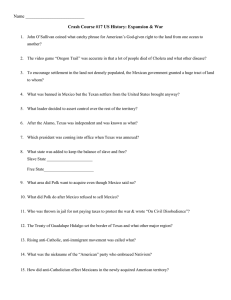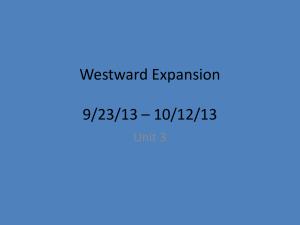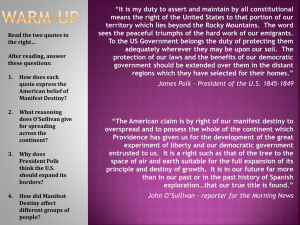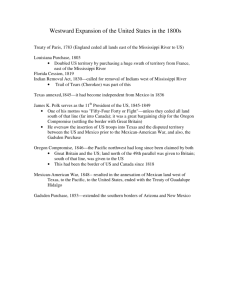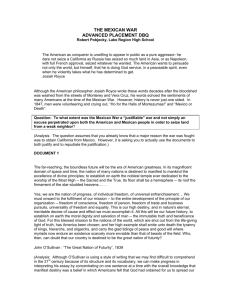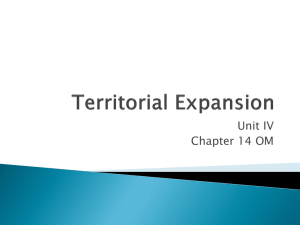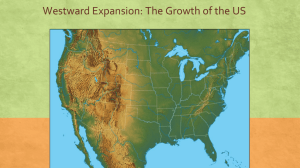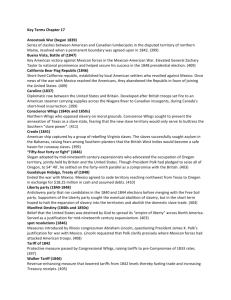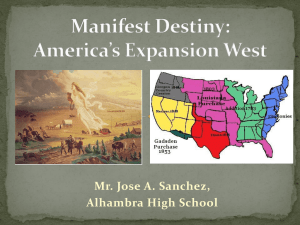MANIFEST DESTINY AGITATION AND ACTIONS TO EXPAND U.S.
advertisement
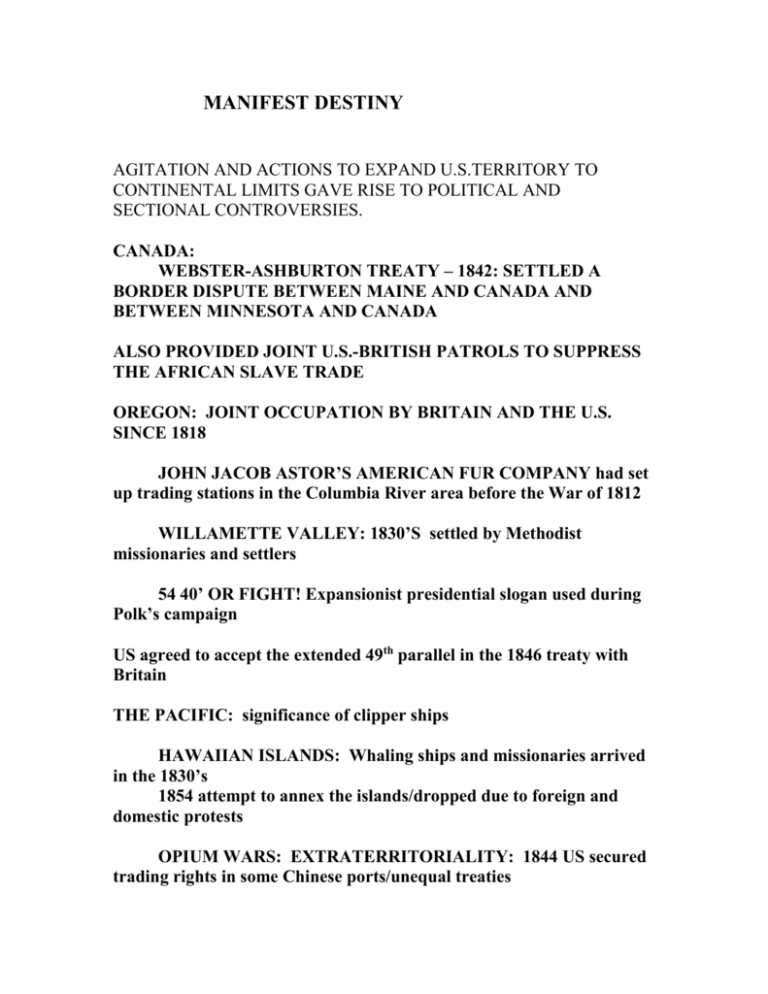
MANIFEST DESTINY AGITATION AND ACTIONS TO EXPAND U.S.TERRITORY TO CONTINENTAL LIMITS GAVE RISE TO POLITICAL AND SECTIONAL CONTROVERSIES. CANADA: WEBSTER-ASHBURTON TREATY – 1842: SETTLED A BORDER DISPUTE BETWEEN MAINE AND CANADA AND BETWEEN MINNESOTA AND CANADA ALSO PROVIDED JOINT U.S.-BRITISH PATROLS TO SUPPRESS THE AFRICAN SLAVE TRADE OREGON: JOINT OCCUPATION BY BRITAIN AND THE U.S. SINCE 1818 JOHN JACOB ASTOR’S AMERICAN FUR COMPANY had set up trading stations in the Columbia River area before the War of 1812 WILLAMETTE VALLEY: 1830’S settled by Methodist missionaries and settlers 54 40’ OR FIGHT! Expansionist presidential slogan used during Polk’s campaign US agreed to accept the extended 49th parallel in the 1846 treaty with Britain THE PACIFIC: significance of clipper ships HAWAIIAN ISLANDS: Whaling ships and missionaries arrived in the 1830’s 1854 attempt to annex the islands/dropped due to foreign and domestic protests OPIUM WARS: EXTRATERRITORIALITY: 1844 US secured trading rights in some Chinese ports/unequal treaties COMMODORE MATTHEW PERRY and his “black ships” were sent by Japan by President Fillmore in 1853. “Show of force” led to trade treaty 5 years later and westernization. THE CARIBBEAN: TARGET: CUBA Southern extremists were interested in the prospect of new slave territory. In 1848 Spain rejected our offer to buy Cuba. Private soldiers of fortune attempted to seize Cuba in 1848 and Nicaragua in 1855-1860. American diplomats in Europe issued the Ostend Manifesto, threatening to seize the island. GADSDEN PURCHASE: 1853 The U.S. bought this “slice of land” from Mexico for possible railroad construction. This completed the acquisition of contiguous territory on the North American continent. ALASKA: 1867 Purchased from Russia for $7.2 million. William Seward was Secretary of State for President Andrew Johnson. “worthless icebox”/Seward’s Folly THE TEXAS PROBLEM: CLAIMS TO TEXAS: The U.S. gave up claims to Texas in the 1819 Florida treaty with Spain, which defined the border of the Louisiana territory. 1821: Mexican Independence from Spain Twice Mexico rejected U.S. offers to purchase Texas. AMERICAN SETTLERS: Offers of large tracts of free land. Stephen F. Austin 1825 Colonization Law: settlers were expected to become Roman Catholics and Mexican citizens. Some brought slaves to the area, but Mexico banned slavery in 1830. Mexico tried to close its borders, but illegal American immigrants continued to enter Texas. REBELLION: General Santa Anna attempted to centralize control after he seized power. Rebellious Texans declared their right to secede. March 1836 – Independence declare and a constitution was drawn up. THE ALAMO: Santa Anna defeated the defenders in San Antonio. BATTLE AT SAN JACINTO: Defeat of Mexicans by Sam Houston’s forces. TEXAS INDEPENDENCE: July 1836 U.S. recognition LONE STAR REPUBLIC: President Sam Houston Request for U.S. annexation/9 years of independence Recognition by Britain and France for trade purposes ANNEXATION TREATY: Annexation was opposed by Americans who feared the expansion of slave territory. Since the necessary 2/3rd approval of the Senate was not achieved, approval was achieved by joint resolution(a simple majority vote) just before the inauguration of Polk in March 1845. Mexico broke diplomatic relations with the U.S. March 1846-Mission by John Slidell failed to negotiate a settlement including purchase of California CAUSES OF THE MEXICAN AMERICAN WAR: General Zachary Taylor and American troops entered disputed territory between the Rio Grande and Nueces Rivers and were attacked by Mexican troops. WAR MESSAGE: May 11, 1846 President Polk claimed Mexico was the aggressor. “(Mexico) has passed the boundary of the United States, has invaded our territory, and shed American blood upon the American soil.” War vote: 40-2 in the Senate/174-14 in the House All opposition votes were from the North. Opposition to the war grew immediately, especially in the North among anti-slavery groups. Mexican advantages: 1. 2. 3. AMERICAN VICTORIES: General Zachary Taylor: American fleet General Winfield Scott Americans took Mexico City. OPPOSITION TO THE WAR: Congressman Abraham Lincoln: Henry David Thoreau Wilmot Proviso: TREATY OF GUADALUPE HIDALGO: 1. 2. 3. EFFECTS OF THE WAR 1. 2. 3. 4. 5. CALIFORNIA: Bear Flag Republic June 1846 Significance of the gold rush: Applied for Admission: DEBATE: THE COMPROMISE OF 1850: 5 SEPARATE BILLS 1. California 2. New Mexico 3.Utah territory 4.District of Columbia 5.FUGITIVE SLAVE LAW REACTION TO THE FUGITIVE SLAVE LAW “personal liberty laws” Underground railroad Mobs Abelman v. Booth 1859
